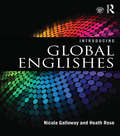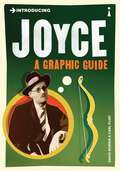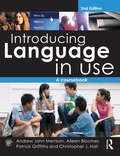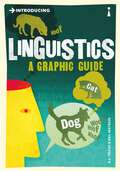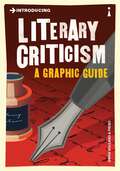- Table View
- List View
Introducing Global Englishes
by Nicola Galloway Heath RoseIntroducing Global Englishes provides comprehensive coverage of relevant research in the fields of World Englishes, English as a Lingua Franca, and English as an International Language. The book introduces students to the current sociolinguistic uses of the English language, using a range of engaging and accessible examples from newspapers (Observer, Independent, Wall Street Journal), advertisements, and television shows. The book: Explains key concepts connected to the historical and contemporary spread of English. Explores the social, economic, educational, and political implications of English’s rise as a world language. Includes comprehensive classroom-based activities, case studies, research tasks, assessment prompts, and extensive online resources. Introducing Global Englishes is essential reading for students coming to this subject for the first time.
Introducing Global Englishes
by Nicola Galloway Heath RoseIntroducing Global Englishes provides comprehensive coverage of relevant research in the fields of World Englishes, English as a Lingua Franca, and English as an International Language. The book introduces students to the current sociolinguistic uses of the English language, using a range of engaging and accessible examples from newspapers (Observer, Independent, Wall Street Journal), advertisements, and television shows. The book: Explains key concepts connected to the historical and contemporary spread of English. Explores the social, economic, educational, and political implications of English’s rise as a world language. Includes comprehensive classroom-based activities, case studies, research tasks, assessment prompts, and extensive online resources. Introducing Global Englishes is essential reading for students coming to this subject for the first time.
Introducing Interpreting Studies
by Franz PöchhackerA millennial practice which emerged as a profession only in the twentieth century, interpreting has recently come into its own as a subject of academic study. This book introduces students, researchers and practitioners to the fast-developing discipline of Interpreting Studies. Written by a leading researcher in the field, Introducing Interpreting Studies covers interpreting in all its varied forms, from international conference to community-based settings, in both spoken and signed modalities. The book first guides the reader through the evolution of the field, reviewing influential concepts, models and methodological approaches. It then presents the main areas of research on interpreting, and identifies present and future trends in Interpreting Studies. Featuring chapter summaries, guides to the main points covered, and suggestions for further reading, Franz Pöchhacker’s practical and user-friendly textbook is the definitive map of this important and growing discipline. Introducing Interpreting Studies gives a comprehensive overview of the field and offers guidance to those undertaking research of their own. The book is complemented by The Interpreting Studies Reader (Routledge, 2002), a collection of seminal contributions to research in Interpreting Studies, and by the comprehensive Routledge Encyclopedia of Interpreting Studies (Routledge, 2015).
Introducing Interpreting Studies
by Franz PöchhackerA millennial practice which emerged as a profession only in the twentieth century, interpreting has recently come into its own as a subject of academic study. This book introduces students, researchers and practitioners to the fast-developing discipline of Interpreting Studies. Written by a leading researcher in the field, Introducing Interpreting Studies covers interpreting in all its varied forms, from international conference to community-based settings, in both spoken and signed modalities. The book first guides the reader through the evolution of the field, reviewing influential concepts, models and methodological approaches. It then presents the main areas of research on interpreting, and identifies present and future trends in Interpreting Studies. Featuring chapter summaries, guides to the main points covered, and suggestions for further reading, Franz Pöchhacker’s practical and user-friendly textbook is the definitive map of this important and growing discipline. Introducing Interpreting Studies gives a comprehensive overview of the field and offers guidance to those undertaking research of their own. The book is complemented by The Interpreting Studies Reader (Routledge, 2002), a collection of seminal contributions to research in Interpreting Studies, and by the comprehensive Routledge Encyclopedia of Interpreting Studies (Routledge, 2015).
Introducing Interpreting Studies
by Franz PöchhackerThis bestselling textbook, now fully updated, introduces students, researchers and practitioners to the fast-developing discipline of Interpreting Studies. Written by one of the world’s leading researchers in Interpreting Studies, Introducing Interpreting Studies covers interpreting in all its varied forms, from international conference to community-based settings, in both spoken and signed modalities. The book first guides the reader through the evolution of the field, reviewing influential concepts, models and methodological approaches. It then presents the main areas of research on interpreting, and identifies present and future trends in Interpreting Studies. This edition has been updated to reflect recent advances in areas from cognitive neuroscience to multimodal discourse analysis and to cover technology-assisted and technology-mediated forms of interpreting, and the role of technology in interpreter training. Featuring chapter summaries, guides to the main points covered, and suggestions for further reading, Franz Pöchhacker’s practical and user-friendly textbook is the definitive map of this important and growing discipline. Introducing Interpreting Studies gives a comprehensive overview of the field and offers guidance to those undertaking research of their own. The book is complemented by The Interpreting Studies Reader (Routledge, 2002), a collection of seminal contributions to research in Interpreting Studies, and by the comprehensive Routledge Encyclopedia of Interpreting Studies (Routledge, 2015).
Introducing Interpreting Studies
by Franz PöchhackerThis bestselling textbook, now fully updated, introduces students, researchers and practitioners to the fast-developing discipline of Interpreting Studies. Written by one of the world’s leading researchers in Interpreting Studies, Introducing Interpreting Studies covers interpreting in all its varied forms, from international conference to community-based settings, in both spoken and signed modalities. The book first guides the reader through the evolution of the field, reviewing influential concepts, models and methodological approaches. It then presents the main areas of research on interpreting, and identifies present and future trends in Interpreting Studies. This edition has been updated to reflect recent advances in areas from cognitive neuroscience to multimodal discourse analysis and to cover technology-assisted and technology-mediated forms of interpreting, and the role of technology in interpreter training. Featuring chapter summaries, guides to the main points covered, and suggestions for further reading, Franz Pöchhacker’s practical and user-friendly textbook is the definitive map of this important and growing discipline. Introducing Interpreting Studies gives a comprehensive overview of the field and offers guidance to those undertaking research of their own. The book is complemented by The Interpreting Studies Reader (Routledge, 2002), a collection of seminal contributions to research in Interpreting Studies, and by the comprehensive Routledge Encyclopedia of Interpreting Studies (Routledge, 2015).
Introducing Joyce: A Graphic Guide (Introducing...)
by David NorrisJames Joyce is one of the most famous--and controversial--writers of the twentieth century. The myth of his difficulty has discouraged many readers from works such as "Ulysses," but David Norris explores his life and work in this engaging and intellectually rigorous introduction.
Introducing Language and Intercultural Communication
by Jane JacksonIntroducing Language and Intercultural Communication is a lively and accessible introduction for undergraduates who are new to the area of intercultural communication. Incorporating real-life examples from around the world and drawing on current research, this text argues against cultural stereotyping and instead provides students with a skill-building framework to enhance understanding of the complexities of language and intercultural communication in diverse international settings. Readers will learn to understand and become aware of power relations, positioning and the impact of social and political forces on language choice and the intercultural communication process. This is the essential text for undergraduate students studying courses in intercultural communication for the first time. Features include: clear learning objectives to structure your study end of chapter discussion questions to test your knowledge highlighted glossary terms to provide a strong understanding of the relevant vocabulary an array of photos including signs which make use of non-verbal codes and many examples that illustrate such issues as intercultural misunderstandings and the effects of culture shock substantial online resources for students including learning objectives, suggested readings, links to media resources and real-world intercultural scenarios and activities. Additional in-depth instructor resources feature test materials, powerpoints, key terms, extended chapter outlines and sample assignments and syllabi.
Introducing Language and Intercultural Communication
by Jane JacksonIntroducing Language and Intercultural Communication is a lively and accessible introduction for undergraduates who are new to the area of intercultural communication. Incorporating real-life examples from around the world and drawing on current research, this text argues against cultural stereotyping and instead provides students with a skill-building framework to enhance understanding of the complexities of language and intercultural communication in diverse international settings. Readers will learn to understand and become aware of power relations, positioning and the impact of social and political forces on language choice and the intercultural communication process. This is the essential text for undergraduate students studying courses in intercultural communication for the first time. Features include: clear learning objectives to structure your study end of chapter discussion questions to test your knowledge highlighted glossary terms to provide a strong understanding of the relevant vocabulary an array of photos including signs which make use of non-verbal codes and many examples that illustrate such issues as intercultural misunderstandings and the effects of culture shock substantial online resources for students including learning objectives, suggested readings, links to media resources and real-world intercultural scenarios and activities. Additional in-depth instructor resources feature test materials, powerpoints, key terms, extended chapter outlines and sample assignments and syllabi.
Introducing Language and Intercultural Communication
by Jane JacksonIntroducing Language and Intercultural Communication is a lively and accessible introduction for undergraduates who are new to the study of intercultural communication, with a particular emphasis on the language dimension. Incorporating real-life examples from around the world and drawing on current research, this text argues against cultural stereotyping and instead provides students with a skill-building framework to enhance understanding of the complexities of language and intercultural communication in diverse international settings. Readers will learn to become more attuned to power relations and the ways in which sociopolitical forces can influence language choice/attitudes and the intercultural communication process. Features new to this edition include: Revised in-text discussion questions and the introduction of multiple exercises and examples that aim to engage students and provide a more interactive experience; New material that takes account of key social, cultural, and political events such as the refugee crisis, Brexit and the rise of populism in many parts of the world Updated theoretical constructs that reflect recent trends in this area of study such as criticality in intercultural communication An updated Companion Website featuring suggested readings, links to media resources and real-world intercultural scenarios for students, as well as additional in-depth instructor resources featuring test materials, PowerPoints, key terms, extended chapter outlines, and sample assignments and syllabi Refreshed references and glossary to enhance understanding of key terms and concepts. This is the essential text for undergraduate students who are new to the field of intercultural communication.
Introducing Language and Intercultural Communication
by Jane JacksonIntroducing Language and Intercultural Communication is a lively and accessible introduction for undergraduates who are new to the study of intercultural communication, with a particular emphasis on the language dimension. Incorporating real-life examples from around the world and drawing on current research, this text argues against cultural stereotyping and instead provides students with a skill-building framework to enhance understanding of the complexities of language and intercultural communication in diverse international settings. Readers will learn to become more attuned to power relations and the ways in which sociopolitical forces can influence language choice/attitudes and the intercultural communication process. Features new to this edition include: Revised in-text discussion questions and the introduction of multiple exercises and examples that aim to engage students and provide a more interactive experience; New material that takes account of key social, cultural, and political events such as the refugee crisis, Brexit and the rise of populism in many parts of the world Updated theoretical constructs that reflect recent trends in this area of study such as criticality in intercultural communication An updated Companion Website featuring suggested readings, links to media resources and real-world intercultural scenarios for students, as well as additional in-depth instructor resources featuring test materials, PowerPoints, key terms, extended chapter outlines, and sample assignments and syllabi Refreshed references and glossary to enhance understanding of key terms and concepts. This is the essential text for undergraduate students who are new to the field of intercultural communication.
Introducing Language and Intercultural Communication
by Jane JacksonThis fully updated third edition of Introducing Language and Intercultural Communication provides an accessible, lively introduction for students who are new to the study of intercultural communication, with special attention devoted to the language dimension. Incorporating real-life examples from around the world and drawing on current research, this text argues against cultural stereotyping and instead provides students with a skill-building framework to enhance understanding of the complexities of language use and intercultural communication in diverse settings. Readers will learn to become more attuned to power relations and the ways in which a complex mix of internal and external factors can influence language choice/attitudes, the intercultural communication process, and intercultural relationship building. Features new to this edition include: ‘pause and reflect’ boxes and images throughout each chapter that encourage meaning making and connections between theories and practice dialogues and student accounts of intercultural experiences that link theories with real-life applications discussion questions, journal jumpstarts, and suggested activities at the end of each chapter to engage students and provide a more interactive experience new material that takes account of key social, cultural, and political events, such as the COVID-19 pandemic, the refugee crisis, the climate emergency, and the rise of populism updated theoretical constructs that reflect recent developments in this area of study, such as criticality and reflexivity in intercultural communication refreshed references and glossary to enhance understanding of key terms and concepts revised and updated Instructor and Student Resources, including recommended resources on intercultural pedagogy, sample course schedules and assignments, in-depth chapter-specific resources, and a test bank revised and updated student resources, including suggested readings and links to online resources, key terms for each chapter, e-flash cards, study quizzes, and a glossary This is the essential textbook for introductory courses in language and intercultural communication within applied linguistics and communication studies.
Introducing Language and Intercultural Communication
by Jane JacksonThis fully updated third edition of Introducing Language and Intercultural Communication provides an accessible, lively introduction for students who are new to the study of intercultural communication, with special attention devoted to the language dimension. Incorporating real-life examples from around the world and drawing on current research, this text argues against cultural stereotyping and instead provides students with a skill-building framework to enhance understanding of the complexities of language use and intercultural communication in diverse settings. Readers will learn to become more attuned to power relations and the ways in which a complex mix of internal and external factors can influence language choice/attitudes, the intercultural communication process, and intercultural relationship building. Features new to this edition include: ‘pause and reflect’ boxes and images throughout each chapter that encourage meaning making and connections between theories and practice dialogues and student accounts of intercultural experiences that link theories with real-life applications discussion questions, journal jumpstarts, and suggested activities at the end of each chapter to engage students and provide a more interactive experience new material that takes account of key social, cultural, and political events, such as the COVID-19 pandemic, the refugee crisis, the climate emergency, and the rise of populism updated theoretical constructs that reflect recent developments in this area of study, such as criticality and reflexivity in intercultural communication refreshed references and glossary to enhance understanding of key terms and concepts revised and updated Instructor and Student Resources, including recommended resources on intercultural pedagogy, sample course schedules and assignments, in-depth chapter-specific resources, and a test bank revised and updated student resources, including suggested readings and links to online resources, key terms for each chapter, e-flash cards, study quizzes, and a glossary This is the essential textbook for introductory courses in language and intercultural communication within applied linguistics and communication studies.
Introducing Language in Use: A Course Book
by Andrew John Merrison Aileen Bloomer Patrick Griffiths Christopher J. HallIntroducing Language in Use, second edition, provides a lively and accessible introduction to the study of language and linguistics. Drawing on a vast range of data and examples of language in its many forms, this book provides students with the tools they need to analyse real language in diverse contexts. The second edition of this best-selling textbook has been fully revised and updated with entirely new chapters on Phonology and Sociolinguistics, two separate chapters on syntax and grammar, completely rewritten chapters on Multilingualism, Psycholinguistics and World Englishes, and a greater focus on corpus linguistics. Introducing Language in Use: covers all the core areas and topics of language study, including semiotics, communication, grammar, phonetics, phonology, words, semantics, variety in language, history of English, world Englishes, multilingualism, psycholinguistics, sociolinguistics, language acquisition, conversation analysis, pragmatics and politeness adopts a 'how to' approach, encouraging students to apply their knowledge as they learn it draws on examples of language from around the world in forms ranging from conversation to advertising and text messaging, always giving precedence to real language in use includes activities throughout the text and an extensive glossary of terms The book is supported by a companion website offering a wealth of additional resources including commentaries on the activities in the book, suggested further reading and references, links to useful websites, more texts to analyse, additional web activities, ‘fun with language’ exercises, discussion questions and an additional ‘Language in Education’ chapter. This is an essential coursebook for all introductory courses in English language, communication and linguistics. Visit the companion website at www.routledge.com/cw/merrison
Introducing Language in Use: A Course Book
by Andrew John Merrison Aileen Bloomer Patrick Griffiths Christopher J. HallIntroducing Language in Use, second edition, provides a lively and accessible introduction to the study of language and linguistics. Drawing on a vast range of data and examples of language in its many forms, this book provides students with the tools they need to analyse real language in diverse contexts. The second edition of this best-selling textbook has been fully revised and updated with entirely new chapters on Phonology and Sociolinguistics, two separate chapters on syntax and grammar, completely rewritten chapters on Multilingualism, Psycholinguistics and World Englishes, and a greater focus on corpus linguistics. Introducing Language in Use: covers all the core areas and topics of language study, including semiotics, communication, grammar, phonetics, phonology, words, semantics, variety in language, history of English, world Englishes, multilingualism, psycholinguistics, sociolinguistics, language acquisition, conversation analysis, pragmatics and politeness adopts a 'how to' approach, encouraging students to apply their knowledge as they learn it draws on examples of language from around the world in forms ranging from conversation to advertising and text messaging, always giving precedence to real language in use includes activities throughout the text and an extensive glossary of terms The book is supported by a companion website offering a wealth of additional resources including commentaries on the activities in the book, suggested further reading and references, links to useful websites, more texts to analyse, additional web activities, ‘fun with language’ exercises, discussion questions and an additional ‘Language in Education’ chapter. This is an essential coursebook for all introductory courses in English language, communication and linguistics. Visit the companion website at www.routledge.com/cw/merrison
Introducing Linguistics (Learning about Language)
by Jonathan Culpeper Beth Malory Claire Nance Daniel Van Olmen Dimitrinka Atanasova Sam Kirkham Aina CasaponsaIntroducing Linguistics brings together the work of scholars working at the cutting-edge of the field of linguistics, creating an accessible and wide-ranging introductory level textbook for newcomers to this area of study. The textbook: • Provides broad coverage of the field, comprising five key areas: language structures, mind and society, applications, methods, and issues; • Presents the latest research in an accessible way; • Incorporates examples from a wide variety of languages – from isiZulu to Washo – throughout; • Treats sign language in numerous chapters as yet another language, rather than a ‘special case’ confined to its own chapter; • Includes recommended readings and resource materials, and is supplemented by a companion website. This textbook goes beyond description and theory, giving weight to application and methodology. It is authored by a team of leading scholars from the world-renowned Lancaster University department, who have drawn on both their research and extensive classroom experience. Aimed at undergraduate students of linguistics, Introducing Linguistics is the ideal textbook to introduce students to the field of linguistics.
Introducing Linguistics (Learning about Language)
by Jonathan Culpeper Beth Malory Claire Nance Daniel Van Olmen Dimitrinka Atanasova Sam Kirkham Aina CasaponsaIntroducing Linguistics brings together the work of scholars working at the cutting-edge of the field of linguistics, creating an accessible and wide-ranging introductory level textbook for newcomers to this area of study. The textbook: • Provides broad coverage of the field, comprising five key areas: language structures, mind and society, applications, methods, and issues; • Presents the latest research in an accessible way; • Incorporates examples from a wide variety of languages – from isiZulu to Washo – throughout; • Treats sign language in numerous chapters as yet another language, rather than a ‘special case’ confined to its own chapter; • Includes recommended readings and resource materials, and is supplemented by a companion website. This textbook goes beyond description and theory, giving weight to application and methodology. It is authored by a team of leading scholars from the world-renowned Lancaster University department, who have drawn on both their research and extensive classroom experience. Aimed at undergraduate students of linguistics, Introducing Linguistics is the ideal textbook to introduce students to the field of linguistics.
Introducing Linguistics: Theoretical And Applied Approaches
by de Garavito, Joyce Bruhn John W. SchwieterIntroducing Linguistics: A Graphic Guide (Introducing... #0)
by R. L. TraskCovering thinkers from Aristotle to Saussure and Chomsky, "Introducing Linguistics" reveals the rules and beauty that underlie language, our most human skill.
Introducing Literary Criticism: A Graphic Guide (Introducing...)
by Owen HollandFrom Plato to Virginia Woolf, Structuralism to Practical Criticism, Introducing Literary Criticism charts the history and development of literary criticism into a rich and complex discipline. Tackling disputes over the value and meaning of literature, and exploring theoretical and practical approaches, this unique illustrated guide will help readers of all levels to get more out of their reading.
Introducing M.A.K. Halliday
by Bo Wang Yuanyi MaM.A.K. Halliday (1925–2018) was the founder of Systemic Functional Linguistics (SFL) and, undoubtedly, one of the most influential linguists of his time, credited with changing the way that language and linguistics have been taught. SFL, as an appliable theory that approaches language as social semiotic, is the study of the relationship between language and its functions in social settings. Moreover, SFL conceives of language as a resource for making meaning and organizes language systemically as a huge network of interrelated choices of meaning. This book is an introduction to the life and seminal works of Halliday. Targeting both SFL and non-SFL scholars, this book introduces Halliday’s life and work in simple terms, expounds his theoretical conceptions, illustrates how his theories have been applied to various areas of linguistics and offers additional readings for researchers who want to explore this area further. Divided into six sections covering Hallidayan connections, theory and architecture of language, Hallidayan conceptions of language, systems and the modes of meaning, and applications of SFL, this accessible introduction is a key resource for researchers and students within the fields of linguistics and applied linguistics.
Introducing M.A.K. Halliday
by Bo Wang Yuanyi MaM.A.K. Halliday (1925–2018) was the founder of Systemic Functional Linguistics (SFL) and, undoubtedly, one of the most influential linguists of his time, credited with changing the way that language and linguistics have been taught. SFL, as an appliable theory that approaches language as social semiotic, is the study of the relationship between language and its functions in social settings. Moreover, SFL conceives of language as a resource for making meaning and organizes language systemically as a huge network of interrelated choices of meaning. This book is an introduction to the life and seminal works of Halliday. Targeting both SFL and non-SFL scholars, this book introduces Halliday’s life and work in simple terms, expounds his theoretical conceptions, illustrates how his theories have been applied to various areas of linguistics and offers additional readings for researchers who want to explore this area further. Divided into six sections covering Hallidayan connections, theory and architecture of language, Hallidayan conceptions of language, systems and the modes of meaning, and applications of SFL, this accessible introduction is a key resource for researchers and students within the fields of linguistics and applied linguistics.
Introducing Metaphor
by Murray Knowles Rosamund MoonIntroducing Metaphor provides an excellent introduction to the theory and applications of metaphor in text analysis. Beginning with an overview of the basic concepts of literal and non-literal language, the book then progresses to areas such as multiword metaphor and psycholinguistic processing. The authors then proceed to demonstrate how metaphor is used in various kinds of writing, including literature, journalism from the United Kingdom, the United States and Australia, showing that metaphor can be used to mediate political opinion. Moon and Murray also examine metaphor in relation to lifestyle, health and food and relate these examples back to the theory of metaphor and ideology. A much needed introductory text, Introducing Metaphor will provide students with a clear overview of the key areas in this widely studied subject and includes a conclusion looking at researching metaphor, a glossary, and annotated further reading.
Introducing Morphology (PDF)
by Rochelle LieberMorphology is the study of how words are put together. A lively introduction to the subject, this textbook is intended for undergraduates with relatively little background in linguistics. Providing data from a wide variety of languages, it includes hands-on activities such as 'challenge' boxes, designed to encourage students to gather their own data and analyze it, work with data on websites, perform simple experiments, and discuss topics with each other. There is also an extensive introduction to the terms and concepts necessary for analyzing words. Unlike other textbooks it anticipates the question 'is it a real word?' and tackles it head on by looking at the distinction between dictionaries and the mental lexicon. This second edition has been thoroughly updated, including new examples and exercises as well as a detailed introduction to using linguistic corpora to find and analyze morphological data.
Introducing Morphology (Cambridge Introductions To Language And Linguistics Ser.)
by Rochelle LieberA lively introduction to morphology, this textbook is intended for undergraduates with relatively little background in linguistics. It shows students how to find and analyze morphological data and presents them with basic concepts and terminology concerning the mental lexicon, inflection, derivation, morphological typology, productivity, and the interfaces between morphology and syntax on the one hand and phonology on the other. By the end of the text students are ready to understand morphological theory and how to support or refute theoretical proposals. Providing data from a wide variety of languages, the text includes hands-on activities designed to encourage students to gather and analyse their own data. The third edition has been thoroughly updated with new examples and exercises. Chapter 2 now includes an updated detailed introduction to using linguistic corpora, and there is a new final chapter covering several current theoretical frameworks.
